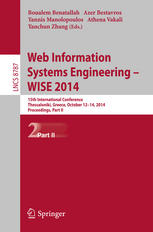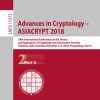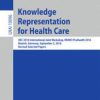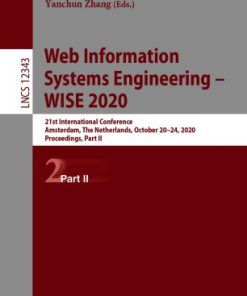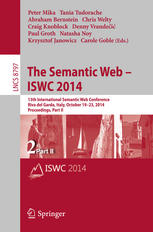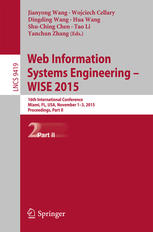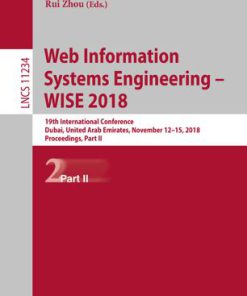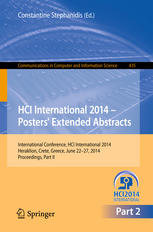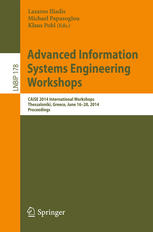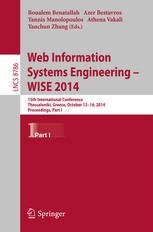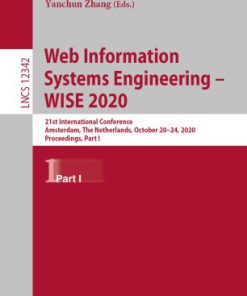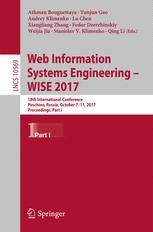Web Information Systems Engineering WISE 2014 15th International Conference Thessaloniki Greece October 12 14 2014 Proceedings Part II 1st Edition by Boualem Benatallah, Azer Bestavros, Yannis Manolopoulos, Athena Vakali, Yanchun Zhang ISBN 3319117467 9783319117461
$50.00 Original price was: $50.00.$25.00Current price is: $25.00.
Web Information Systems Engineering WISE 2014 15th International Conference Thessaloniki Greece October 12 14 2014 Proceedings Part II 1st Edition by Boualem Benatallah, Azer Bestavros, Yannis Manolopoulos, Athena Vakali, Yanchun Zhang – Ebook PDF Instant Download/Delivery: 3319117467, 9783319117461
Full download Web Information Systems Engineering WISE 2014 15th International Conference Thessaloniki Greece October 12 14 2014 Proceedings Part II 1st Edition after payment
Product details:
ISBN 10: 3319117467
ISBN 13: 9783319117461
Author: Boualem Benatallah, Azer Bestavros, Yannis Manolopoulos, Athena Vakali, Yanchun Zhang
This book constitutes the proceedings of the 15th International Conference on Web Information Systems Engineering, WISE 2014, held in Thessaloniki, Greece, in October 2014. The 52 full papers, 16 short and 14 poster papers, presented in the two-volume proceedings LNCS 8786 and 8787 were carefully reviewed and selected from 196 submissions. They are organized in topical sections named: Web mining, modeling and classification; Web querying and searching; Web recommendation and personalization; semantic Web; social online networks; software architectures amd platforms; Web technologies and frameworks; Web innovation and applications; and challenge.
Web Information Systems Engineering WISE 2014 15th International Conference Thessaloniki Greece October 12 14 2014 Proceedings Part II 1st Table of contents:
1 Introduction
2 Related Work
2.1 Election Prediction on Social Networks
2.2 Sub-Event Detection from Social Networks
2.3 Sentiment Analysis on Social Networks
3 Proposed Approach
3.1 Sub-Event Detection for a Particular Event
3.2 Political Sentiment Analysis
3.3 Election Prediction Model
4 Experiments and Evaluation
4.1 Dataset and Experimental Setting
4.2 Baseline Approaches
4.3 Evaluation
5 Conclusions
References
Sonora: A Prescriptive Model for Message Authoring on Twitter
Introduction
RelatedWork
Approach
Evaluation
Applications
Conclusion
References
A Fuzzy Model for Selecting Social Web Services
1 Introduction
2 Social Web Services
3 Existing Fuzzy Models to Select Web Services
4 A Fuzzy Model to Select Social Web Services
4.1 Fuzzification
4.2 Social Quality Weight Computation Phase
4.3 Capturing User Requirements
4.4 Defuzzification Phase
4.5 Ranking Social Web Services
5 Experiments
6 Conclusion
References
Insights into Entity Name Evolution on Wikipedia
1 Introduction
2 Handling of Name Changes on Wikipedia
3 Analysis Method
3.1 Research Questions
3.2 Procedure
4 Analysis Results
4.1 Wikipedia Dataset
4.2 Statistics about Name Changes on Wikipedia List Pages
4.3 Statistics about Evolution Mentions in Wikipedia Articles
5 Generalization and Discussions
5.1 Towards Generalization
5.2 Discussion
6 Related Work
7 Conclusions and Future Work
References
Assessing the Credibility of Nodes on Multiple-Relational Social Networks
1 Introduction
2 Related Works
3 Methodology
3.1 Problem Definition
3.2 Trust Similarity
3.3 Credibility
4 Experiment
4.1 Datasets
4.2 Distribution of Credibility
4.3 Comparison of Credibility with Ranking
4.4 Connection to Balance Theory
4.5 Case Study
5 Conclusion
References
Result Diversification for Tweet Search
1 Introduction
2 Features for Tweet Ranking
3 Tweet Ranking Using Diversification Methods
4 Experiments
5 Related Work
5.1 Ranking Tweets
5.2 Diversifying Web Search Results
6 Conclusion
References
WikipEvent: Leveraging Wikipedia Edit History for Event Detection
1 Introduction
2 Related Work
2.1 Temporal Information Retrieval and Event Detection
2.2 Mining from Wikipedia
3 Approach
3.1 Overview
3.2 Problem Formalization
3.3 Workflow
4 Relationship Identification
4.1 Explicit Relationships Identification
4.2 Implicit Relationships Identification
5 EventDetection
5.1 Temporal Graph and Entity Clustering
5.2 Event Identification
6 Experiments and Evaluations
6.1 Dataset
6.2 Implementation Details
6.3 Quantitative Analysis
6.4 Qualitative Analysis
6.5 Comparative Analysis
7 Conclusions and Future Work
References
Feature Based Sentiment Analysis of Tweets in Multiple Languages
1 Introduction
2 Related Work
3 Feature Based Sentiment Analysis
3.1 Extraction of Product Features
3.2 Performing Sentiment Analysis on Tweets
4 Merging the Results of All Languages
5 Experimental Results
5.1 Preparation of the Experiment
5.2 Extraction of Product Features
5.3 Sentiment Analysis Results
6 Conclusion and Future Work
References
Incorporating the Position of Sharing Action in Predicting Popular Videos in Online Social Networks
1 Introduction
2 Data Collection and Basic Properties
2.1 Background of the Renren Social Network
2.2 Data Collection
2.3 Video Popularity in Renren
3 Sharing Actions in Different Positions of Video Diffusion
3.1 Definition of Video Initiators
3.2 Characteristics of Sharing Actions with Different Position
4 Predicting Popular Videos Based on Specified Experts
4.1 Expert Selection Model
4.2 Experiments on Predicting Popular Videos
5 Conclusion and Future Work
References
An Evolution-Based Robust Social Influence Evaluation Method in Online Social Networks
1 Introduction
1.1 Background
1.2 The Problem
1.3 Contributions
2 Related Work
3 Preliminary
3.1 Social Network
3.2 Trust Relationship and Transaction Relationship
3.3 Evolutionary Trust Model
4 Influence Impact Factors
4.1 Total Trustworthiness (TT)
4.2 Fluctuant Trend of Being Advisor (FTBA)
4.3 Fluctuant Trend of Total Trustworthiness (FTT)
4.4 Trustworthiness Area (TA)
5 The Evalution-Based Robust Social Influence Method
6 Experiments
6.1 Experimental Setting
6.2 Experimental Results
7 Conclusion and Future Work
References
A Framework for Linking Educational Medical Objects: Connecting Web2.0 and Traditional Education
1 Introduction
2 Background
3 Overview of System Framework for Developing LEMO Data Model
4 LEMOProposedDataModel
5 Harvesting, Mapping and Enriching Educational Objects
6 Experiments and Results
7 Conclusions and Future Work
References
An Ensemble Model for Cross-Domain Polarity Classification on Twitter
1 Introduction
2 Background
3 Methodology
4 Experimental Study
4.1 Twitter Test Datasets
4.2 Model Building
5 Results
6 Conclusion
References
A Faceted Crawler for the Twitter Service
1 Introduction
2 Related Work
3 Twitter API Background
3.1 REST API
3.2 Streaming API
4 Faceted Crawler Architecture
4.1 Streaming API
4.2 REST-Based Crawling
4.3 Scheduler
4.4 Ranker
4.5 Seeder
4.7 Crawl Flow
5 Use Cases
5.1 Crawling by Location
5.2 Crawling User Timelines
5.3 Sampling
5.4 Additional Use Cases
6 Conclusion
References
Diversifying Microblog Posts
1 Introduction
2 Related Work
3 Microblog Diversification
3.1 Problem Formulation
3.2 Diversification Criteria
3.3 Diversification Process
4 Evaluation
4.1 Dataset Used
4.2 Methodology
5 Conclusion
References
Software Architectures and Platforms
MultiMasher: Providing Architectural Support and Visual Tools for Multi-device Mashups
1 Introduction
2 Background
3 Concepts for Multi-device Mashups
4 MultiMasher
4.1 Global View
4.2 Mashup View
4.3 Co-browsing Feedback
5 Architecture and Implementation
6 Evaluation
6.1 Conceptual Evaluation
6.2 Technical Evaluation
7 Conclusion
References
MindXpres: An Extensible Content-Driven Cross-Media Presentation Platform
1 Introduction
2 Background
3 Requirements
4 MindXpres Platform
4.1 Document Format and Authoring Language
4.2 Compiler
4.3 MindXpres Presentation Bundle
4.4 Plug-in Types
5 Implementation
5.1 Document Format and Authoring Language
5.2 Compiler
5.3 Presentation Engine
6 Use Cases
6.1 Structured Overview Plug-in
6.2 Slide Plug-in
6.3 Enhanced Video Plug-in
6.4 Source Code Visualisation Plug-in
7 Discussion and Future Work
8 Conclusion
References
Open Cross-Document Linking and Browsing Based on a Visual Plug-in Architecture
1 Introduction
2 Background
3 Open Cross-Document Linking
3.1 General Open Cross-Document Link Service Architecture
3.2 Communication with Plug-ins
3.3 Open Cross-Document Link Service Components
4 HTML, PDF, Text and XML Plug-ins
5 Discussion and Future Work
6 Conclusion
References
Cost-Based Join Algorithm Selection in Hadoop
1 Introduction
2 Background
2.1 Hadoop and Hive
2.2 Join Algorithms in Hadoop
3 CostModel
4 Cost-Based Selector
4.1 Pruned Join Algorithm Candidates Tree
4.2 Select Join Algorithm Based on Cost Model
5 Experiment
5.1 Effect of the Number of Buckets
5.2 Correctness of Cost-Based Selector
6 Related Work
7 Conclusion
References
Consistent Freshness-Aware Caching for Multi-Object Requests
1 Introduction
2 Freshness-Aware Caching
2.1 Freshness Concept
3 Multi-Object Freshness-Aware Caching (MOFAC)
3.1 Example
4 MOFAC Algorithm
4.1 Multi Object Freshness Read
4.2 Update Handling on Local Cache Node
4.3 Update Handling: Processing Update-Notifications
5 Evaluation
5.1 Benchmark Application
5.2 Evaluation Setup
5.3 Evaluation of MOFAC’s Overhead
5.4 Evaluation of Invalidation vs. MOFAC with Varying Update
5.5 Evaluation of Varying Freshness Limit and Varying MPL
6 Related Work
7 Conclusions and Future Work
References
�-Controlled-Replicate: An Improved Controlled-Replicate Algorithm for Multi-way Spatial Join Proc
1 Introduction
2 Related Work
3 Notation
4 Map-Reduce Framework and Spatial Joins
4.1 Handling 2-way Overlap Joins
4.2 Handling Multi-way Overlap Joins
5 Controlled-Replicate (C-Rep)
7 Experimental Evaluation
7.1 Experimental SetUp
7.2 Synthetic Data
7.3 California Road DataSet
7.4 Choosing the Value of
8 Conclusion
References
REST as an Alternative to WSRF: A Comparison Based on the WS-Agreement Standard
1 Introduction
2 Evaluation
2.1 Test Scenarios
2.2 Test Infrastructure
2.3 Impact of Security Technology
2.4 Measurement Results
3 Related Work
4 Conclusion
References
Web Technologies and Frameworks
Enabling Cross-Platform Mobile Application Development: A Context-Aware Middleware
1 Introduction
2 Context-Awareness in Mobile Platforms
3 HTML: Features and Browser Support
4 HTML5 Context Middleware
5 Context-Aware Sensor and Reasoner Modules
6 Use Case Evaluation
7 Conclusions
References
GEAP: A Generic Approach to Predicting Workload Bursts for Web Hosted Events
1 Introduction
2 Generic Event Aware Prediction
2.1 Event Repositories
2.2 The Workload Burst Model
2.3 The Prediction Module
2.4 Identifying Similar Events
2.5 GEAP Assumptions
3 Evaluation Metrics
4 Evaluation
4.1 Methodology
5 Results and Discussion
5.1 Correction Factor and Prediction Horizon Effects
5.2 The Value of Time and Secondary Features
6 Conclusion
References
High-Payload Image-Hiding Scheme Based on Best-Block Matching and Multi-layered Syndrome-Trellis Cod
1 Introduction and Related Works
2 Preliminaries
2.1 The k-Means Clustering Method
2.2 Sydrome-Trellis Codes and their Multi-Layered Construction
3 The Proposed Method
3.1 The Embedding Phase
3.2 The Extracting Phase
4 Experimental Results and Analysis
5 Conclusion
References
Educational Forums at a Glance: Topic Extraction and Selection
1 Introduction
2 Related Work
3 Motivation
4 Topic Extraction and Selection
4.1 Entity Extraction and Enrichment
4.2 Topic Extraction
4.3 Topic Selection
4.4 Topic Recommendation
5 Evaluation Setup
5.1 Technology Acceptance Model Evaluation
5.2 Expert Assessment
6 Results
6.1 Technology Acceptance Model Results
6.2 Assessment Results by Distance Learning Experts
6.3 Discussion Evolution
7 Discussion and Outlook
References
PDist-RIA Crawler: A Peer-to-Peer Distributed Crawler for Rich Internet Applications
1 Introduction
2 Related Works
3 Overview of the PDist-RIA Crawler
3.1 Algorithm
3.2 Termination
4 Performance Measurements
4.1 Time to Transmit Messages
4.2 Time to Calculate the Task to Execute
4.3 Number of Events in Tasks
5 Evaluation
5.1 Test-Bed
5.2 Target Applications
5.3 Results
6 Conclusion and Future Improvements
References
Understand the City Better: Multimodal Aspect-Opinion Summarization for Travel
1 Introduction
2 Related Work
3 Problem Formulation
4 Multimodal Aspect-Opinion Summarization
4.1 Informative Sentence Selection
4.2 Text Summarization
4.3 Text to Image Association
5 Experiments
5.1 Dataset and Experimental Settings
5.2 Summarization Performance
6 Conclusion
References
Event Processing over a Distributed JSON Store: Design and Performance
1 Introduction
2 Insight to Action
3 Leveraging JSON
4 Integrated Distributed JSON Store
4.1 MongoDB
4.2 Integration with Insight to Action
5 Experimental Evaluation
6 Related Work
7 Conclusion
References
Cleaning Environmental Sensing Data Streams Based on Individual Sensor Reliability
1 Introduction
2 Related Work
3 Reliability-Weighted Prediction
3.1 The Faulty Data Patterns and the Cleaning Procedure
3.2 Influence Mean Cleaning
3.3 Incremental Reliability Update
4 Experimental Analysis on Synthetic and Real Dataset
4.1 Influence Meaning Cleaning in a Synthetic Dataset
4.2 Influence Mean Cleaning in a Real Dataset
5 Conclusion and Future Work
References
Managing Incentives in Social Computing Systems with PRINGL
1 Introduction
2 PRINGL Overview
3 Modeling Incentives with PRINGL
3.1 PRINGL Language Constructs
3.2 Implementation
3.3 Discussion
4 Related Work
5 Conclusions and Future Work
References
Consumer Monitoring of Infrastructure Performance in a Public Cloud
1 Introduction
2 Related Work
3 Key Challenges
4 Data and Empirical Strategy
5 Results
6 Conclusion and Future Work
References
Business Export Orientation Detection throughWeb Content Analysis
1 Introduction
2 Background
3 Experimental Environment
3.1 Framework
3.2 Data
4 Results
4.1 Baseline Model
4.2 Construction and Validation of AutomaticWeb-Based Indicators
4.3 Predicting Export Orientation from AutomaticWeb Indicators
5 Conclusions
References
Web Innovation and Applications
Towards Real Time Contextual Advertising
1 Introduction
2 Current Model of Contextual Advertising
3 A New Approach
3.1 Phase 1: Offline Processing
3.2 Phase 2: Online Processing
4 Experiments
4.1 Design of Experiments
5 Results
6 Discussion
7 Conclusion
References
On String Prioritization in Web-Based User Interface Localization
1 Introduction
1.1 Research Goals and Contributions
2 Research Background
2.1 Related Work
2.2 User Interface Localization Challenges
3 System Overview
3.1 Prioritization Features
4 Evaluation
4.1 Experimental Setup
4.2 Procedure
4.3 Dataset
4.4 Feature Analysis for User-Driven Prioritization
4.5 String Retrieval for Fine-Grained Prioritization
4.6 General Discussion
5 Conclusion and Future Work
References
Affective, Linguistic and Topic Patterns in Online Autism Communities
1 Introduction
2 Related Work
3 Method
3.1 Datasets
3.2 Affective Information
3.3 Topics and Language Style
3.4 Feature Selection and Classification
4 Result
4.1 Affective Analysis
4.2 Blogpost Classification and Feature Selection
5 Conclusion
References
A Product-Customer Matching Framework for Web 2.0 Applications
1 Introduction
2 Problem Statement
2.1 Preliminary
2.2 Problem Formulation
3 Data Preprocessing
4 Query Processing
4.1 Reverse Top-
4.2 Analysis
4.3 Algorithm Description
5 Experimental Results
5.1 Data Description
5.2 Effectiveness Study
5.3 Efficiency Study
6 Related Work
7 Conclusion
References
Rapid Development of Interactive Applications Based on Online Social Networks
1 Introduction
2 Motivating Examples
3 Architecture
4 A DSL for Describing Patterns
5 A DSL for Queries and Actions
6 Tool Support
7 Related Work
8 Conclusions and Future Work
References
Introducing the Public Transport Domain to the Web of Data
1 Introduction
2 Related Work
2.1 Data Models in Public Transport
2.2 Ontologies for the Public Transport Domain
2.3 Public Transport as Linked Open Data
3 An Ontology for Public Transport Services and Data
3.1 Ontology Development
3.2 Core Concepts
3.3 Prototype
4 Conclusion
References
Measuring and Mitigating Product Data Inaccuracy in Online Retailing
1 Introduction
2 Related Work
2.1 Data Quality Dimensions
2.2 Data Quality on the Web
2.3 Mitigation Strategies to Improve Data Quality
3 Research Method
4 Result Analysis
4.1 Data Accuracy
4.2 Data Inaccuracy Mitigation Approaches
4.3 Potential Causes for Data Inaccuracy
5 New Approach to Mitigate Data Inaccuracy
6 Conclusion, Limitation and Further Work
References
Challenge
WISE 2014 Challenge: Multi-label Classification of Print Media Articles to Topics
1 Introduction
2 Learning Methods
3 Thresholding Methods
4 Conclusions
People also search for Web Information Systems Engineering WISE 2014 15th International Conference Thessaloniki Greece October 12 14 2014 Proceedings Part II 1st:
web information systems engineering wise 2014
web information systems
web information systems engineering
engineering information systems
business information systems wmu
Tags:
Boualem Benatallah,Azer Bestavros,Yannis Manolopoulos,Athena Vakali,Yanchun Zhang,Web Information,Systems Engineering,WISE 2014,International Conference,Thessaloniki,Greece
You may also like…
Computers - Computer Science
Computers - Computer Science
Computers - Programming
Computers - Computer Science


